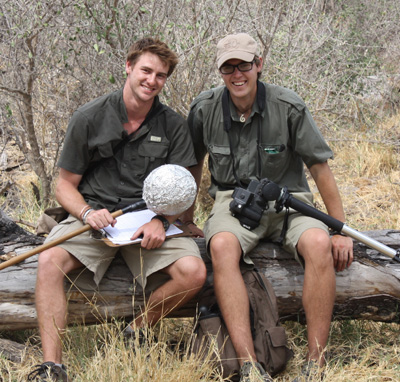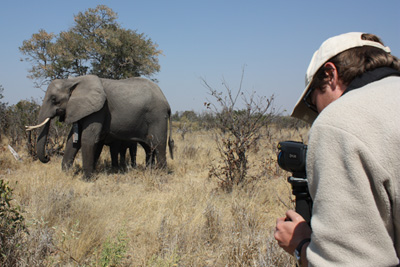The “Hot Boys” are Back
Most of us know how elephants like to cool themselves off in the hot African sun, by either minimizing their movements under the shade of a tree, taking a cool swim in the river, or tossing water from a natural pan over their backs and then cover themselves with clouds of dirt or dust. Flapping their massive ears, where capillaries are large and very close to the skin, also helps to regulate their temperature by creating a cool draft along the ears underside. However, very little is known on how the four main environmental factors: solar radiation, wind velocity, ambient water vapour pressure and long-wave radiation effect the core body temperature of an elephant. And in, turn how does their core body temperature effect their behaviour? Could the rising temperatures of climate change be affecting elephants’ choice of habitat and possibly their daily movements? Could this have any bearing on how long elephants hide at lengths of time under the umbrella of a tree? and, how does this behaviour effect the ecosystem and biodiversity?
Questions like these are what EWB have begun to try and answer by supporting and hosting two Masters student’s projects from the University of Pretoria, supervised by Prof. Rudi Van Aarde. Shaun D’Araujo and Michael Mole, whom we respectfully nicknamed the “hot boys” due to the topic of their research, have just returned to continue their second season of fieldwork with us, now based out of EWB’s Research Station in the NG26 concession in the Okavango Delta. Their studies are trying to determine the effects of environmental conditions on elephant’s skin and core temperatures throughout the changing temperature of day and night. Environmental conditions and microclimates are being monitored by portable weather stations and black globes. Meanwhile, Mike and Shaun are conducting thorough behavioural observations on elephants, as well as, recording skin and core temperatures of elephants by using a calibrated infrared thermal camera and miniature data-loggers.
We are pleased that Shaun and Mike are back at camp and we know they will provide us with very interesting results and information from their research. Studying how elephants respond to their thermal environment through physiological responses to core temperature and behaviour responses to skin temperature, may provide a much better understanding of the localized impact elephants are having on habitats, which in turn can better inform management strategies of the habitat elephants choose to utilize.
If you’d like to learn more about Elephants Without Borders projects: http://www.elephantswithoutborders.org/index.php
If you’d like to support our projects: http://www.elephantswithoutborders.org/donate.php
and, you can Follow us on Facebook: https://www.facebook.com/elephantswithoutborders
- Infrared thermal image of mother elephant and her calf
Tags: africa, behavior, botswana, climate change, conservation, delta, elephants, elephants without borders, Okavango delta, research, temperature, wildlife









